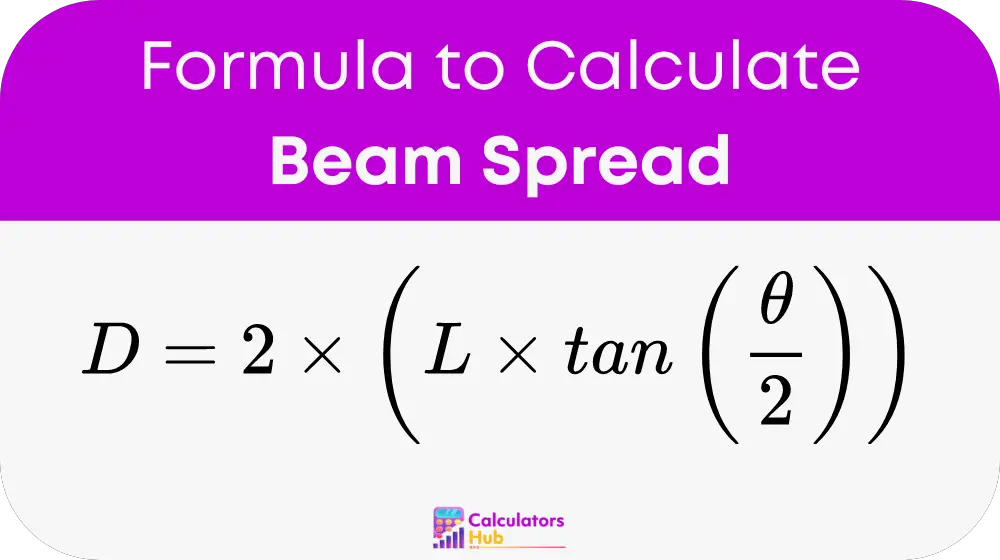The Beam Spread Calculator is a practical tool used in lighting design and planning to determine the spread or diameter of a light beam at a specific distance from the source. This calculation is essential for professionals who need to understand how a light fixture will illuminate a particular area, ensuring the light covers the desired space without leaving any dark spots or wasting energy. The calculator is commonly used in architectural lighting, stage lighting, and even in photography and videography, where precise control over lighting is crucial.
Understanding beam spread helps in choosing the right type of lighting fixtures for different applications, whether it’s for a spotlight effect, general area lighting, or creating specific lighting patterns. By accurately calculating beam spread, designers can optimize the placement and type of light sources, leading to more effective and efficient lighting solutions.
Formula of Beam Spread Calculator
The formula to calculate Beam Spread (D) is:

Where:
- D is the diameter of the beam spread at the given distance.
- L is the distance from the light source to the point where the beam’s spread is being measured.
- θ is the beam angle or the full angle of the light beam.
Steps to Calculate Beam Spread
- Determine the Beam Angle (θ):
The beam angle is usually provided by the manufacturer of the lighting equipment. It represents the full angle of the light beam, defining how wide the beam spreads as it moves away from the source. - Measure the Distance (L):
Measure the distance from the light source to the target or surface where you want to measure the beam spread. This distance is crucial in calculating how wide the beam will be when it hits the surface. - Calculate the Beam Spread (D):
Use the formula above to calculate the diameter of the light beam at the distance L. This will give you the size of the area that will be illuminated by the light source at that distance.
General Terms and Reference Table
Here’s a table with common beam angles and their corresponding beam spreads at a fixed distance. This reference can help designers quickly estimate beam spread without needing to perform the calculation every time.
| Beam Angle (θ) | Distance (L) | Beam Spread (D) | Application |
|---|---|---|---|
| 15° | 10 meters | 2.6 meters | Focused spotlight, ideal for highlighting specific areas |
| 30° | 10 meters | 5.3 meters | Narrow beam, suitable for accent lighting |
| 45° | 10 meters | 8.5 meters | General lighting, covering larger areas |
| 60° | 10 meters | 11.5 meters | Wide beam, useful for ambient or flood lighting |
| 90° | 10 meters | 20 meters | Very wide beam, covering extensive areas |
Example of Beam Spread Calculator
Let’s go through an example to see how the Beam Spread Calculator works.
Suppose you have a light fixture with a beam angle of 30°, and you want to know the beam spread at a distance of 8 meters.
Using the formula:
Beam Spread (D) = 2 * (L * tan(θ/2))
First, calculate the angle in radians:
θ/2 = 30°/2 = 15° = 0.2618 radians
Now, calculate the beam spread:
D = 2 * (8 * tan(0.2618))
D = 2 * (8 * 0.2679)
= 2 * 2.1432 = 4.2864 meters
In this example, the beam spread at a distance of 8 meters is approximately 4.29 meters. This means the light will cover a circular area with a diameter of 4.29 meters at that distance.
Most Common FAQs
The beam angle in lighting defines the width of the light beam emitted by a fixture. It’s important because it determines how much area the light will cover. A narrow beam angle creates a focused spot, while a wider beam angle spreads light over a larger area.
As the distance from the light source increases, the beam spread also increases. This means that the further away the light is from the target, the larger the illuminated area will be.
Yes, the Beam Spread Calculator can be use for various types of lighting fixtures, including spotlights, floodlights, and general lighting. However, the accuracy depends on the consistency of the beam angle provided by the manufacturer.